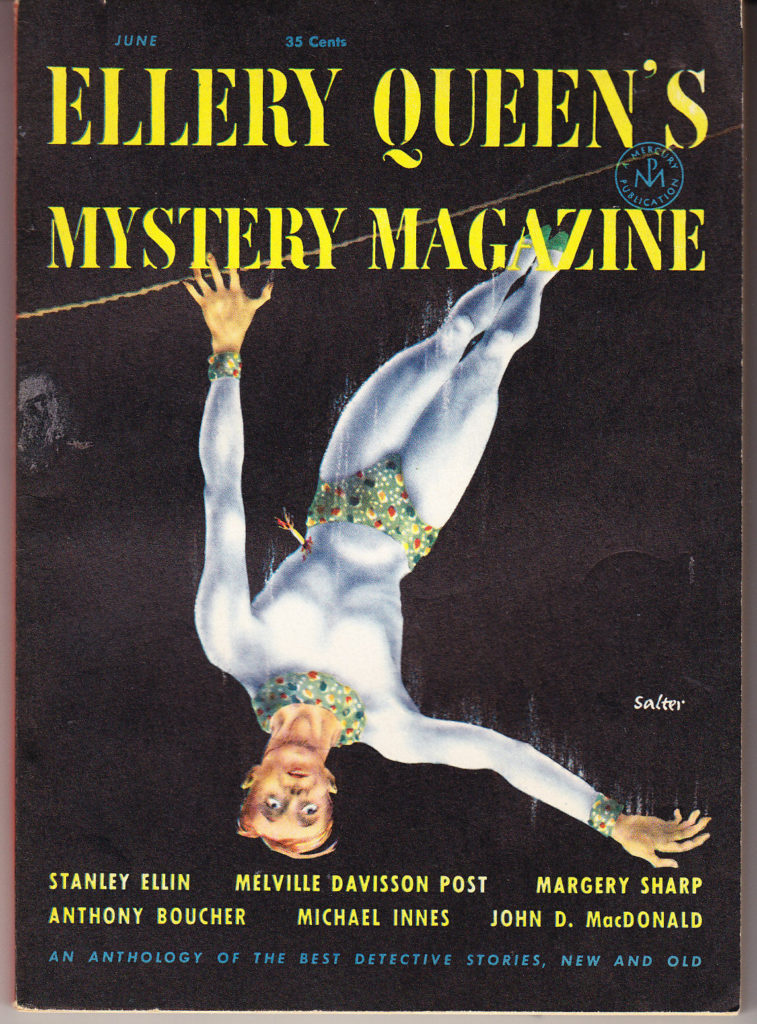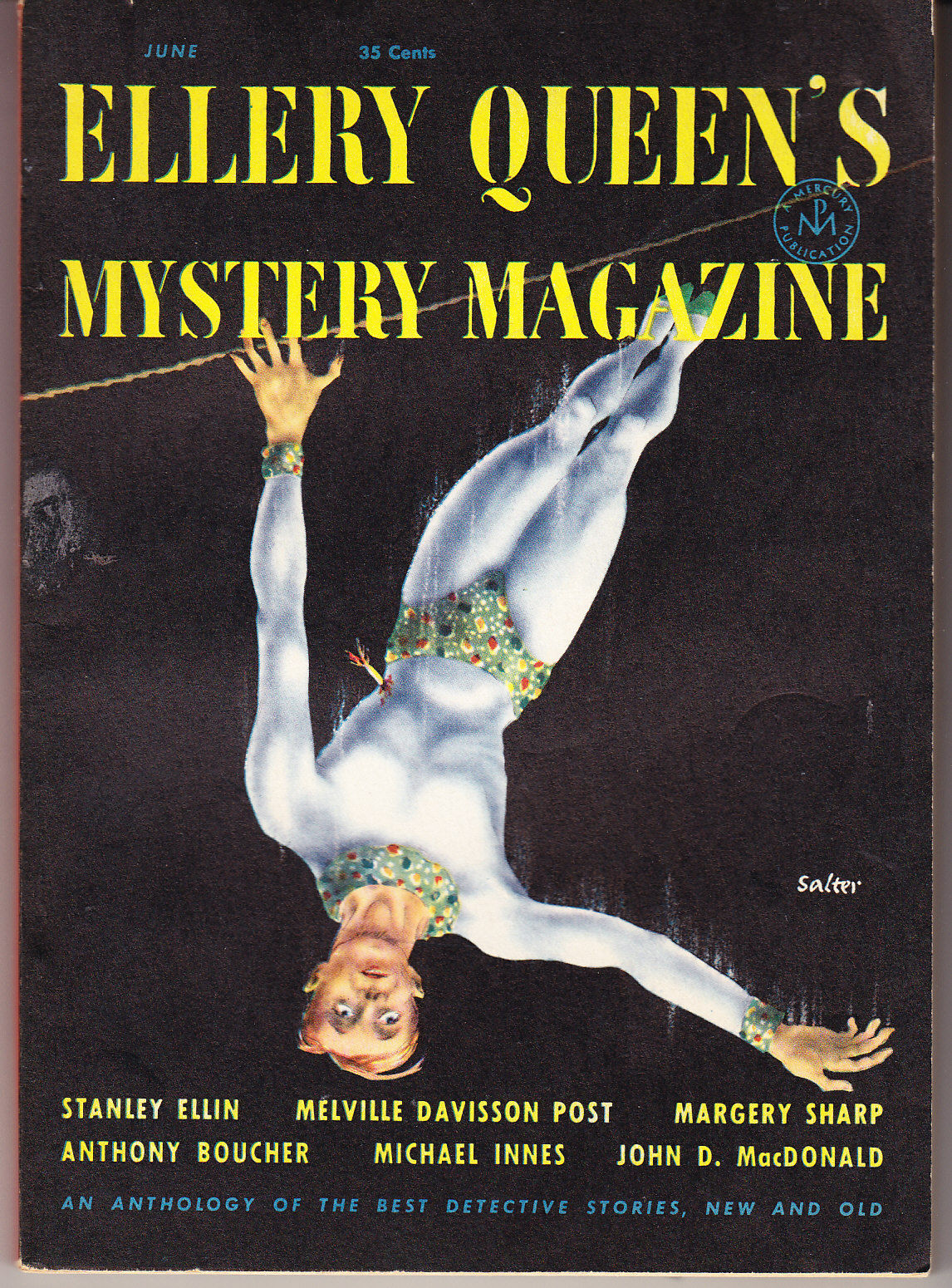Magazine Review: Ellery Queen’s Mystery Magazine June 1953 edited by Ellery Queen
Since this has floated to the top of my TBR pile, let’s look at another vintage issue of this classic mystery magazine. The cover depicting an aerialist falling to presumed death after being stuck with a dart has nothing to do with any of the stories within, but is a striking image.

“The Betrayers” by Stanley Ellin is described by the editorial note as a “chivalry is not dead” story. A credit investigator has never actually interacted with the beautiful woman next door, but the thin apartment walls mean he can hear everything that happens there, and he has fallen in love with her. When he hears the woman’s abusive husband apparently murder her and dispose of the body, he launches an investigation of the woman’s past so that he can build a case to take to the police. While chivalry may not be dead, it’s not exactly healthy.
“Winning Sequence” by Margery Sharp is set in England. Two elderly sisters are asked to get some money for their nephew, who’s in a jam. The only thing they have that’s worth that sum is a heirloom cameo that an acquaintance offered to buy a while back. A train mix-up and some well-meaning gamblers cause the sisters to end up at the racetrack. A humorous story, and a valuable lesson is learned.
“The Numbers Man” by Anthony Boucher is set just after World War Two. A police detective realizes that a particular man with a fascination for base 12 arithmetic has been peripherally involved in a number of murders and suspicious deaths. Turns out the man is almost as good at manipulating people as he is numbers, and his role model is Iago. The cop can’t prove the manipulator is legally liable, but warns him off. But then the jerk shows up at a party the cop’s sister and her new husband are throwing. Who will die?
“One Hundred in the Dark” by Owen Johnson was in the first edition of Fourteen Great Detective Stories in 1928, but removed in the 1949 edition to make way for newer stories that reflected the new state of the art. Since the 1913 book it came from originally was long out of print, Ellery Queen decided to print it in this issue for a new generation of readers.
The story itself is a tale told at a supper club of a socialite’s party where a jewel was stolen by one of the guests, with a deliberately ambiguous ending. It’s an okay story.
“Glimpses of the Moon” by Leslie Bigelow is about a Des Moines accountant who found a incalculable treasure in London, and why he has a check for three pounds, ten shillings mounted on his wall.
“Inspector Appleby’s First Case” by Michael Innes takes us to the series character’s youth. He was fourteen, and witnessed a suspicious event followed by a theft of jade. Things were not quite as they seemed, but he still helped the police solve the case.
“The Panther” by Browning Norton is set in the rural mountains. Something is raiding henhouses and lamb pens. Something large and strong and black and cunning that dogs won’t track. When the farmers of the valley learn that a panther escaped from the circus a few weeks back, they determine to hunt down the dangerous beast. But this is no ordinary panther, rather something the simple folk have never dreamed of.
“A Woman Can Kill” by Raoul Whitfield is a Black Mask reprint. The detective firm of Dancer and Davies is hired to trail a young woman in order to find out if there’s any scandal that can be used to pressure her grandmother into not competing with a beer hall owned by the client. It seems a clear-cut case at first, but turns to murder. The gimmick here is that “Dancer” does not exist; Davies’ real partner is Julie Hazard, who poses as his secretary as she knows she doesn’t look like a tough private eye.
“A Night at the Theater” by Ben Ray Redman is speculative fiction. A man’s television suddenly shows a broadcast of the assassination of Abraham Lincoln; one that is not on the air at that time, and unusually realistic. Did he see the true past, or is it something else?
“Heads I Win, Tails You Lose” by John D. MacDonald is a Black Mask crime story. A small-time gambler has discovered a system of manipulating the different odds in locations across New York City so he can place bets that balance out so that no matter how a sports contest comes out, he will make a small profit. It’s a lot of work, but it’s a better job than he could find honestly. Our protagonist gets caught up in a big-time crook’s far more ambitious bet-rigging scheme, and a double-cross leads to murder. Can he beat the odds? Content note: torture.
“Emerald Bait” by Val Duncan is the tale of a security man working a party to protect an emerald necklace. He’s distracted by a pretty woman, and the necklace goes missing. He’s not as foolish as he first appears.
“Doublecross” by Aljean Meltsir is a “First Story” about a man who’s tracked the man who betrayed him and cost him an arm down after six years. It’s a gimmick story meant to be read all in one sitting or with a good memory. Ms. Meltsir is now known as Aljean Hermetz, and is perhaps best known for her writing on film.
“The God of the Hills” by Melville Davisson Post is a previously lost “Uncle Abner” story. Abner comes to a wealthy judge’s house planning to buy some cattle, but the man is dead, struck down with a blunt instrument. Is it a random event, or connected to a case the judge was hearing (and was financially interested in), or is the will of God? The Uncle Abner tended to have a heavy religious element, but the central mystery has a rational explanation.
It’s set prior to the Civil War in western Virginia, and mention is made of “Negro servants” as opposed to slaves. (In other stories, Uncle Abner is not a fan of slavery, but believes that it should be given up voluntarily rather than abolished from above.)
I like the MacDonald story best, but this is a generally strong lineup. “Doublecross” is the slightest, since it’s all gimmick. Many of these stories have been reprinted in anthologies; good hunting!

